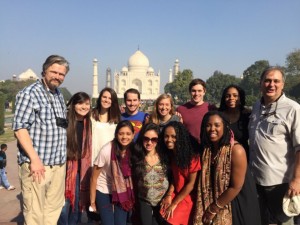Crossing Campuses: WFU’s cross-registration system with Salem College
It’s the first day of Fall semester at WFU and sophomore Emma Battle joins the throngs of students making their way across the brick labyrinth of campus. Tan, blonde, and passable for a J. Crew brand ambassador, she effortlessly blends in the rest of the student body. If anything, Battle represents a quintessential WFU undergrad – actively involved in WFU political clubs, academics, and social scene.
However, as Battle takes her seat in” Latino Political Behaviour” and listens to Professor Wilkinson take attendance, she never hears her name called. The professor seems confused, looking up at Battle and then back to the roster in search of a missing name. When introductions go around the room, one-by-one, the rest of the students find out why.
“My name is Emma Battle,” she says, “but I actually don’t go here.”
Battle, in fact, attends Salem College, a women’s college located 7 miles down University Parkway.
Each semester, approximately 30 students from Salem College enroll in courses at Wake Forest. This is a part of the WFU cross-registration relationship with Salem College, which began in X (*fact check) as a way for both institutions to expand their course offerings. The program allows Salem and Wake Forest students to utilize academic opportunities otherwise not available in their own school’s program. With no extra tuition cost, Salem students are permitted to enroll in Wake Forest courses and vice versa.
For students like Battle, the cross-registration system plays an integral part in expanding her educational horizons.
“When I took ‘Latino Political Behavior’ at Wake Forest, there wasn’t anything like it being offered at Salem at the time,” said Battle. “It’s a great to add diversity to your education, whether that be diversity of opinions, subject matter or even college campuses.”
The registration process itself is less straightforward. According to Melissa Cumbia, Academic Counselor at Wake Forest, the student must first receive approval from the Dean of Academics by writing a brief explanation of why they want to take the class. Once approved to move forward, the student must also contact the course professor and ask for permission to join the roster. On receiving the professor’s approval, the student’s paperwork is then sent to the WFU registrar for processing, but the student will not be formally added to the waitlist until a few days before the start of the course. Even then, the student must remain on the waitlist until the course begins.
“Unfortunately, cross-registered students cannot be put into our system and formally registered until the start of the semester,” Cumbia wrote in an email. “I advise students to contact their professor before the beginning of classes and let them know of their intent to enroll.”
“I registered basically like any other Wake student would,” said Battle. “The only difference was I had to wait until mid-August to ensure the class wasn’t filled by actual Wake students first; that part wasn’t fun, but it comes with the territory I guess.”
The same goes for WFU students who take classes at Salem College. The niche course offerings in Arts Management and Not-for-Profit Management appeal to those looking for more specified areas of study. Wake Forest graduate student Tiansong Zhou was seeking to focus on archeology, a track that can be carved through WFU’s Anthropology Department. However, while searching for more centralized courses, Zhou’s advisor recommended he look into the Salem College course catalog.
….
The process might be haphazard, but it usually resolves well. Salem College junior Ella Hill, an has taken two courses, “Fashion in the Age of the Atlantic Revolution” and “Music History of Winston-Salem,” at Wake Forest and says the experience was fairly smooth both times.
“When I initially reached out to both professors, they were supportive of my desire to join their class, and I have felt incredibly welcomed into the classroom,” says Hill. “I have thoroughly enjoyed my Wake Forest experiences and would highly recommend cross-registering for both Wake Forest and Salem students.”





